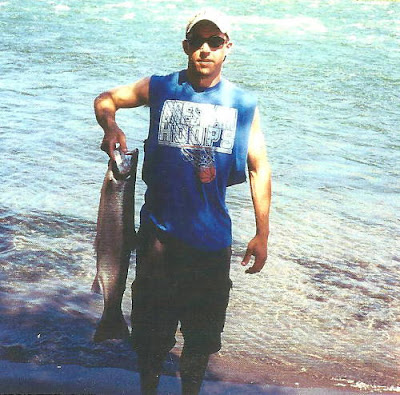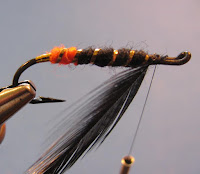 |
| Chuck Stewart showing our catch of Kamloops trout! |
After almost 480 miles we finally reached Huff Lake, B.C. As was the custom back in the early 1960s, we always stopped by Wilson Ranch to get a fresh fishing report. The lake was in good shape so we headed up the rough, dirt road and set up a camp. The Kamloops rainbows had put on a few more pound this season. The fish were in the 5 to 6 pound range with some measuring well over 20 inches. We quickly rigged our rods up and, as in the past, fish began to take my Huff Lake Shrimp pattern aggressively. Inside of two hours we hooked and released a dozen fish or more. We decided to keep a few fish for dinner that evening, and we began to prepare for a late meal.
Back in those years, my cooking utensils were not the state of the art. Everything was fairly clean with the exception of my 14 inch cast iron skillet. It was in absolute disarray. Not only was it dirty, but it was rusty and still had greasy remnants from a previous trip. My dad was stunned and said that it wasn’t fit to eat from. Rob admittedly wasn’t a great cook, but he knew that cast iron had to be kept clean and in good condition. After an hour of completely refurbishing the neglected pan, we prepared a meal with fish as our main entrée. Our meal that evening was very tasty, but not just because of the clean cast iron skillet. It was also because of the fire engine red meat of the Kamloops trout. Their coloration was mainly due to the fish’s avid diet of fresh water shrimp, and to this day my mouth still waters when I think of their rich and savory taste.
Cast iron flying pans and Dutch ovens will last forever if you take care of them. To begin, it’s a good idea to buy American made cast iron to guarantee its quality and heating performance. Good cast iron retains heat evenly and can tolerate high temperatures without any damage. Also, it cooks even better the more you use it.
Methods for properly taking care of cast iron skillet.
1. Clean it with a little hot water. If food is stuck to the pan, use a wooden spoon to scrape it off.
2. Heat the pan to 200 degrees Fahrenheit and then let it cool.
3. Use a rag to reseal the entire pan with a light coating of olive oil and it’s ready for storing.
4. Warm up and cool down cast iron gradually to preserve its longevity.
Things not to do with cast iron skillet:
1. Do not boil water in cast iron because any seasoning will dissipate.
2. Do not place the pan over really high temperatures as this can eventually cause cracking.
Fire it up and enjoy some delicious pan of fried trout!










































